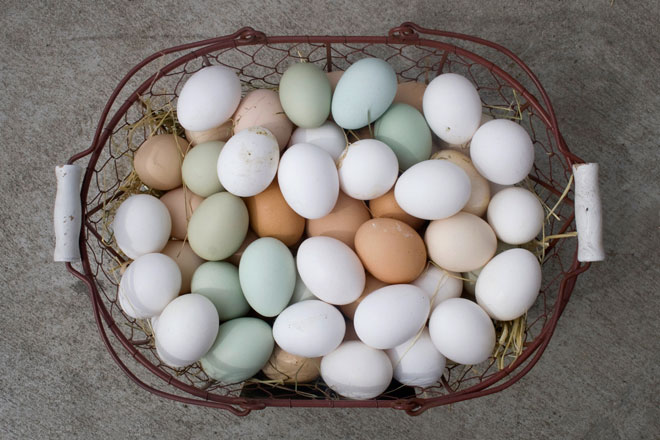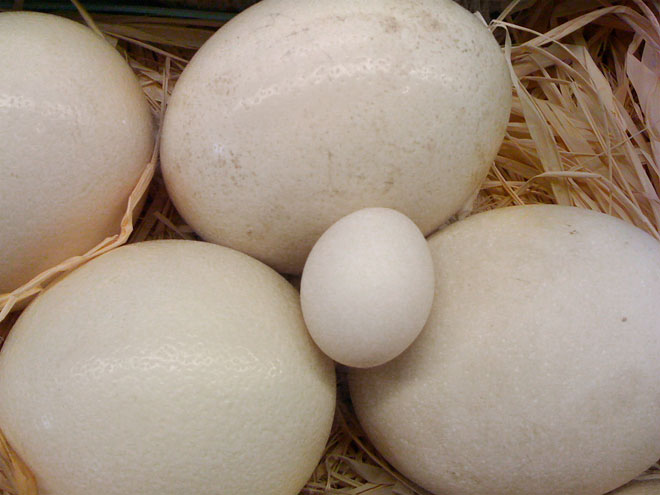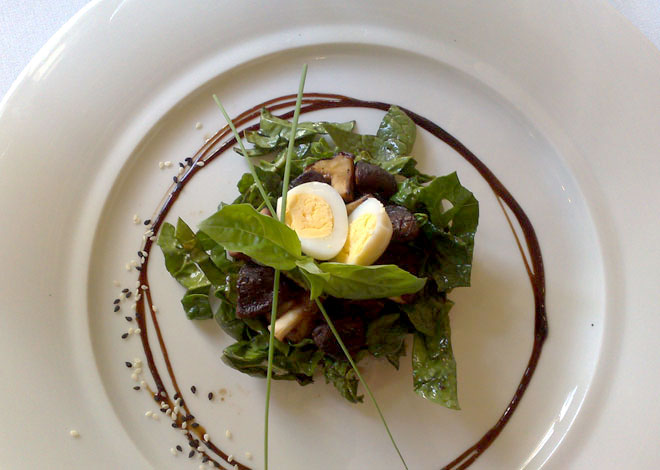Years ago, when print magazines ruled the Earth, an article in Gourmet lit the first embers of the fire that eventually led me to culinary school. It was about the humble omelet.
The essay by Francis Lam (now a judge on Top Chef Masters) extolled the French omelet as the pursuit of perfection.
The French omelet is all about the egg. Perfectly executed, it contains just eggs, a little butter and oil in the pan, salt and pepper (though I prefer white pepper, so there are no black flecks to mar the pale yellow flesh of the finished product). It is smooth, no bumps or bulges of egg curd, the color of butter, and it melts in your mouth.
I recently asked Lam via Twitter (@Francis_Lam) if he still felt the same way about the omelet, as the pinnacle of perfection in the kitchen. His response: “Ain’t nothin’ changed!”
And that’s the beauty of French culinary technique. It doesn’t change, because the results stand the test of time. The same could be said for eggs.
History tells us that wild fowl were domesticated for egg production as far back as 3200 BC. According to the American Egg Board (home of perhaps one of the most catchy slogans ever, “the incredible edible egg”), there is evidence that there were domesticated fowls in North America when Columbus sailed the ocean blue. But, upon a return trip in 1493, he brought with him chickens that became the basis for the stock we know today.
Despite the increase in home chicken-keeping, Americans still get most of our eggs from commercial farms and the stalwart layer, the Single-Comb White Leghorn. U.S. commercial chickens produce about 75 billion eggs a year, or about 10 percent of the world supply.

Single Comb White Leghorns are produce a large share of the white eggs that Americans consume. Breeds such as Barnevelders, Rhode Island Reds, and more produce brown eggs of a range of shades. Araucanas produce blue and green eggs. Image credit: Woodley Wonder Works.
Two-thirds of those eggs are used by consumers, according to the Egg Board, while the rest are used by the foodservice industry and in egg products made by food manufacturers.
There are certainly plenty of other sources of eggs, with more showing up at grocery stores around the country: Duck, quail, ostrich and goose are among the more prevalent newcomers, and most can be used interchangeably with chicken eggs with attention to the portion. According to the American Ostrich Association, an ostrich egg is equivalent to about two dozen chicken eggs—so if you’re cracking one of these five-pounders, plan on company.

A duck egg surrounded by ostrich eggs. Image credit: John Federico.
An easy way to convert recipes is by weight. A chicken yolk weighs around 20 grams, while a white is about 30 grams. Convert accordingly.
That said, non-chicken eggs can be more of a statement on the plate. Pickled hard-boiled quail eggs are a visual delight on a fancy “ladies who lunch” salad. A single sunny-side up goose egg would look gorgeous atop a pan of griddled hash.

A spinach and hard-boiled quail egg salad. Image credit: Tuija Aalto.
As a home cook, I use eggs for so much more than baking. But my favorite use is homemade mayonnaise.
Once you’ve mastered the basics of making your own, you’ll never go back to the jar. The taste is pure and infinitely less sweet than the store-bought variety. (Anytime I taste something sweet that’s supposed to be savory, I immediately suspect corn syrup, which is a no-no in my kitchen.)
In its purest state, basic mayonnaise is the foundation for an endless supply of flavored cold sauces and salad dressings, fish toppings and dips. When I’m making a small batch, I don’t even bother with a food processor. Just a bowl, a whisk, and my imagination.
Making Mayonnaise:
- In a small bowl, separate one egg. Place the yolk in medium bowl, and put the white in a freezer-safe container. (Usually, I put it in a small zipped sandwich bag, label it with the content and the date, and I throw it in the freezer. Whites freeze with no discernible impact on their integrity. You can thaw them and use them as you would a newly separated egg – in meringue, to supplement an omelet, and in recipes. Measure either by portion, if that’s how you froze it, or by weight if you freeze a batch at a time. One white weighs about 30 grams.)
- To the yolk, add a touch of Dijon mustard (start with ¼ teaspoon, and increase to adjust to your tastes), a squirt of lemon (start with ½ teaspoon, adjust accordingly), and a pinch of salt. Whisk together until well combined.
- A typical yolk will absorb between 100-150 grams of fat or oil. I keep my vegetable and olive oils in squeeze bottles, so depending on whether I want a vegetable or an olive oil mayonnaise, they’re within easy reach. (The difference is in taste. When I’m making a garlicky aioli to top croutes or to blend in with a Bouillabaisse, I use extra-virgin olive oil to augment the taste of the Mediterranean; when I’m making a spicy Sriracha-flavored creamy salad dressing, I opt for the neutral palate of vegetable oil.)
- Whisk in the oil slowly, in a steady stream, until the mayonnaise is the consistency you want. If it starts to look greasy or curdled, stop drizzling in the oil and whisk it aggressively until it smooths out. Then keep adding oil to your preferred thickness.
- Taste for seasonings, and whisk in additional salt, lemon juice or mustard as desired. I also add a touch of cayenne pepper, which jumps up the flavor without adding heat. Use with caution.

Eggs, lemon juice, and oil: some of the ingredients you’ll need to make your own mayonnaise. Image credit: Katherine Martinelli.
Just a few of the things I use with this base:
- Lemon: Add 1 teaspoon lemon zest and additional lemon juice to thin the mayo. Uses: Creamy lemon salad dressing, sauce for broiled salmon or asparagus or broccoli.
- Lime and Sriracha: Add 1 teaspoon lime zest, lime juice and a squirt of Sriracha, to your taste and consistency. Uses: Amazing zesty and creamy salad dressing, perfect foil for crab cakes or salmon cakes, complements Merguez sausage.
- Garlic: Mince 1 clove garlic and whisk that in at the beginning with the mustard and lemon juice. The perfect aioli. Uses: Dip for raw vegetables, slather on grilled or toasted rustic bread, blend in soups to add depth and creaminess.
As for the humble French omelet, I must admit that most weekends, you’ll find me, like Francis Lam, at the stove, non-stick skillet in hand, in pursuit of the perfect omelet.
If you make your own omelets, try Martha Stewart’s simple instructions. It’s a different animal from the dry, browned version most of us grew up eating or the over-stuffed blob on the plate at most sticky-tabled diners.
Not that there’s anything wrong with that style of omelet. But, once you’ve experienced the ephemeral egg in perhaps its purest, most incredible, edible state, you may never go back.
Use these products from Hudson Made when preparing and serving your next delicious egg-based meal:
 |
 |
 |
| Flame-Blackened Wide Serving Spoon | Milk & Honey | Worker’s Apron |
Laura Grimmer is a professional cook and sommelier who lives to eat, drink and provide sustenance. She came late to the culinary world, selling her PR firm and enrolling at the French Culinary Institute because of a borderline fixation on master chef Jacques Pépin. She left cooking school a classically trained chef with a deeply seated appreciation for tradition in the kitchen. www.perfectpairnyc.com

